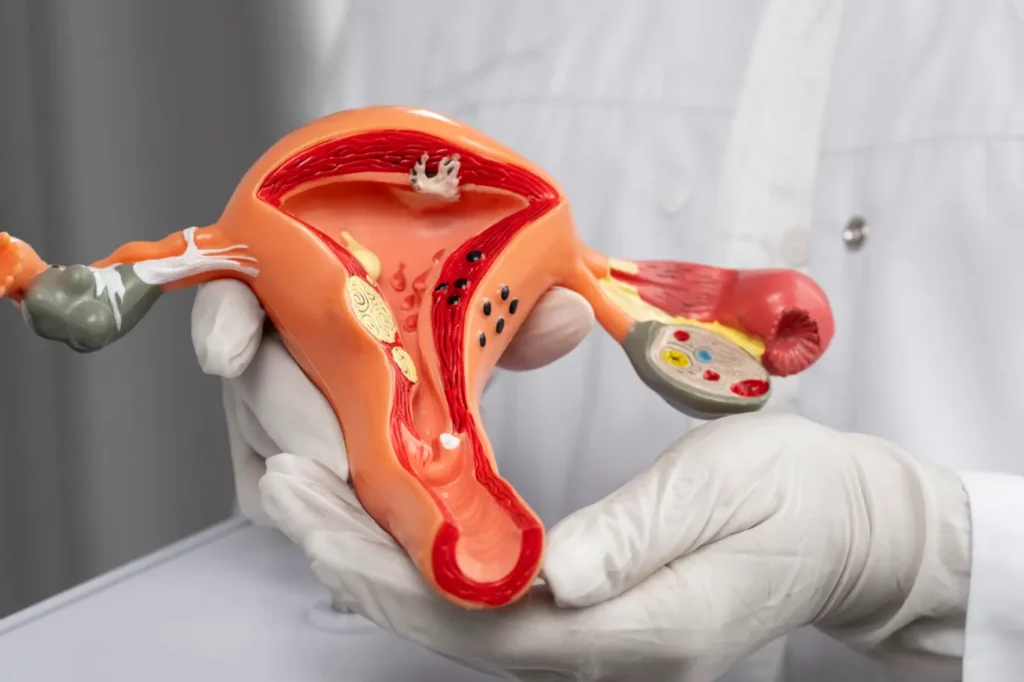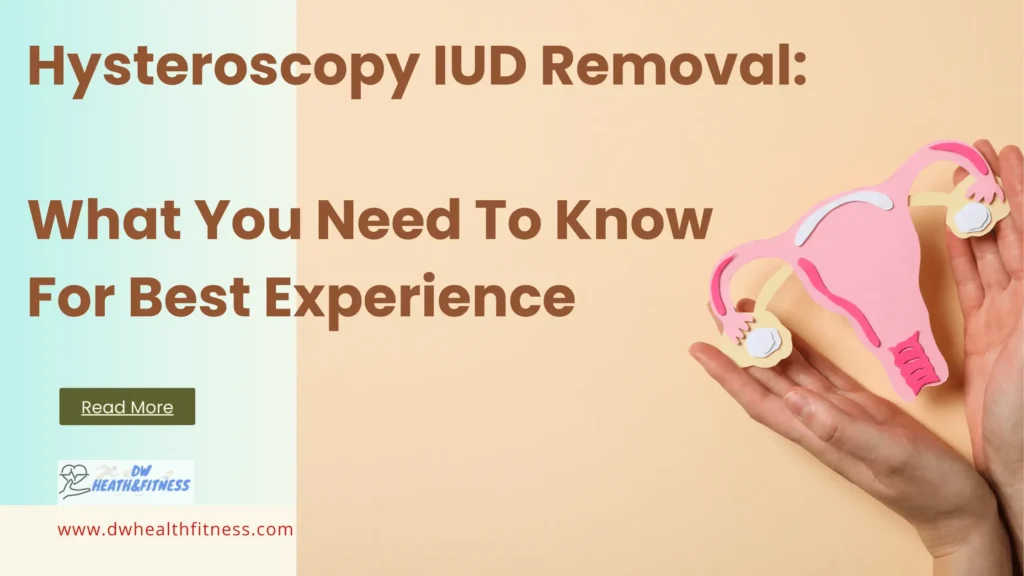Hysteroscopy IUD removal is one of the significant medical procedures from a women’s health perspective that requires a delicate expert touch. This article covers the complete details of hysteroscopy IUD removal and helps you understand the process, different aspects, benefits, possible discomforts, and care afterward.
Get updated knowledge when you prepare for the IUD removal procedure or want to be curious about the process. This comprehensive detail will help you understand the procedure insights with all related facts and figures for the best experience if you plan.

Introduction:
The IUDs (intrauterine devices) are used as contraceptives globally. However, IUDs do not provide 100% confirmation of control, and pregnancies may occur even in the patients carrying the device.
The healthcare provider will perform an IUD removal procedure when the woman wants to proceed with pregnancy. Hysteroscopy IUD removal is a more advanced technique than traditional removal methods.
You can confidently plan the procedure after reviewing the details and its benefits.
Understanding IUDs:
It is a standard method of birth control. IUD prevents pregnancy by diverting the passage so sperm cells cannot meet the eggs. IUD is inserted into the uterus at the right place to prevent pregnancy and can stay there for several years.
However, the IUDs need to be removed or replaced based on pregnancy requirements or due to some other medical conditions.
Types of IUDs:
There are two types of IUDs – copper IUDs and hormonal IUDs.
What is Hysteroscopy IUD Removal?
The Hysteroscopy IUD Removal is a procedure in which the hysteroscopy is inserted into the uterus through the vagina. Hysteroscopy is a flexible, thin tube with a camera and light that helps physicians visualize internal movement and properly place it in the uterus.
The physician takes a biopsy or uses other special instruments to treat any underlying condition if required during the procedure. The Hysteroscopy procedure is also performed to remove adhesions, polyps, or a mispositioned IUD.
When is Hysteroscopy IUD Removal Necessary?
You can plan to remove IUDs in different scenarios, such as:
- You decided to plan pregnancy, and the woman wants to discontinue using it.
- The IUD is no longer effective and requires replacement or removal.
- Women face medical problems, e.g., embedding, displacement, or regular bleeding.
The physician utilizes a hysteroscope, which allows safe entry and inner movement of the tiny instrument in the uterus. The procedure may require anesthesia, which the doctor will decide in the pre-examine phase.
The Hysteroscopy IUD Removal Procedure
Preparation
Your physician will discuss the process and any possible discomfort related to this procedure. He will also answer all of your queries. The physical will discuss a suitable schedule to provide you with the best possible comfort. The doctor may advise you to take pain relievers if required.
Before you come for the IUD removal procedure, shower and refresh yourself. Be relaxed and keep a positive attitude, which will help smooth the process.
The Procedure Itself
The position and condition of an IUD matter significantly during this procedure. Sometimes, the IUD gets attached to your uterine wall. The physical needs a hysteroscopy in this case to carefully remove the IUD. Depending on the conditions, anesthesia may be required for this procedure.
The doctor carefully inserts a hysteroscope into the uterus through the cervix. The camera provides high-quality real-time images, which help the doctor find the IUD location and gently remove it. A set of specialized instruments is used in the procedure.
Duration and Sensation
The duration of this procedure is usually 10 to 40 minutes. During the process, some women feel less pain, but others may find it very severe. You must tell the doctor or treatment staff about your pain if it is unbearable. They will stop the procedure immediately and take the necessary steps.
You may experience mild pain, cramps, light bleeding, or discharge for a few days afterward. Discuss with your doctor if the pain is severe or unbearable.
Benefits of Hysteroscopy IUD Removal
Hysteroscopy IUD Removal is an advanced procedure and has multiple advantages. It gives an accurate view to the surgeon for careful removal of the IUD. The complications are also reduced in this procedure due to its precise approach. The doctor gets an opportunity to quickly find any issues that may come across during the process and, hence, promptly resolve them.
Potential Discomfort and Pain Management
There will be some degree of pain during the hysteroscopy IUD removal. The doctor may give you anesthesia for this procedure or recommend some over-the-counter pain relievers to mitigate potential pain. Your healthcare team will observe you closely and advise you on what is best for you.
As reported by most of the women, the pain felt by this procedure is similar to menstrual cramps, but it varies from person to person. However, the discomfort reduces significantly after the procedure. You can also communicate your concerns to the physician about pain management.
Post-care Tips for a Smooth Recovery
You should immediately contact your doctor for expert advice if you face heavy bleeding, severe pain, or other uncommon symptoms after the procedure. You need to give your body rest and avoid strenuous activities as it helps a lot in a smooth recovery.
However, you may face light spotting, pain, or cramming after the procedure, which you usually recover from with routine medicines given by your doctor. Use a heating pad and stay hydrated; this is vital to speedy recovery.
When to Consult a Doctor
Call your doctor for immediate medical assistance if your pain has not recovered even after taking the medicines. Also, if you cannot pass stool or gas, your vaginal discharge has increased more than average or smells bad.
Comparison: Hysteroscopy Vs. Traditional IUD Removal
Hysteroscopy IUD removal is much better than conventional IUD Removal as it helps to conduct a detailed examination of the uterus and gives precise results. Also, this is a safe option in those cases where conventional ultrasound-guided IUD removal fails and is difficult to perform safely.
Common Concerns
Is the Hysteroscopy IUD Removal Procedure Painful?
You may experience some pain like other medical procedures; however, the pain is much less manageable.
When Can I Resume Normal Activities
Most women resume their normal activities shortly after the procedure, or some take a few hours of rest. Some women wish to take a few more bed days of bed rest before starting their routine activities.
Is this a Risky Procedure
Generally, this procedure is safe with a very minimum level of risk. The minimal level of risk may include infection or injury to the uterus.
Is It Safe To Get a New IUD After Removal
It is entirely safe to get a new IDU after removing your existing one. However, you can discuss the same with your dock and plan appropriately for IUD replacement.
Does insurance cover the IUD Removal Procedure?
Most insurance plans cover the IUD Removal Procedure as a medically required procedure. However, you can review your health insurance plan or consult your insurance advisor for confirmation.
Conclusion
Understanding the procedure and its benefits with related details is suitable before proceeding with Hysteroscopy IUD removal. This procedure is safe and effective as it provides a detailed assessment of the uterus with significantly fewer chances of complications after the procedure.
Related: Hormonal Vs Non-Hormonal Birth Control: What Is the Best Choice?
Frequently Asked Questions:
Is hysteroscopy IUD removal the only method available?
No, the other traditional IUD removal methods are also available but are not much preferred nowadays.
What should I do if I experience severe pain after the procedure?
Your healthcare provider will provide you with the contact details at the time of discharge. You can contact them immediately to get expert advice according to your condition.
Can I undergo hysteroscopy IUD removal if my IUD is expired?
Yes, it is also recommended for your expired IUD removal.
Will I be under anesthesia during the procedure?
Your doctor decides according to your condition. Most of the time, the doctor decides to administer local anesthesia to comfort the patient.
Is hysteroscopy IUD removal safe for women with certain medical conditions?
Your doctor will first assess your health condition and advise whether the procedure is safe.
Can a hysteroscopy remove an IUD?
Yes, the hysteroscopy procedure is performed to remove IUDs.
How is a hysteroscopy done for an IUD?
A hysteroscope is passed through the cervix part, which helps visualize and remove the IUD.
What are the side effects of having an IUD removed?
It may vary from person to person, but common side effects may include discomfort, light spotting, and cramping.
How long does it take to recover from IUD removal?
The recovery time may vary from person to person, but most women recover a few days after the procedure.
What is not normal after IUD removal?
You should immediately communicate with your doctor and seek advice if you have heavy bleeding, excessive pain, or continued discomfort.
Is the first period after IUD removal heavy?
After IUD removal, you may have a slightly heavier first period, but it should not prolong or normalize over time.
Will I lose weight after IUD removal?
Weight loss is not necessarily linked with IUD removal; however, it varies individually along with other factors.
How long does it take for hormones to balance after IUD removal?
Most women achieve average hormone balance in a few months after IUD removal.
Is it painful to have an IUD removed?
The procedure is slightly painful. Some women may experience cramping or discomfort, but doctors manage it with suitable medication.
How do I prepare for an IUD removal?
Your doctor will provide complete guidelines on the necessary preparation for this procedure. You will also get details about a suitable schedule and related pain relievers during your period.
When is the best time to remove the IUD?
It varies per individual. Your doctor will conduct the required medical tests and examine your condition to provide helpful advice that best fits your case.
Does your body change after IUD removal?
Generally, there is no significant change. However, a slight change in the menstrual cycle or other minor changes are reported in some women after the IUD removal procedure.
Do you feel sick after IUD removal?
Most of the women reported no sick feelings after this procedure. However, the response may vary according to the individual’s health condition.
Why do you bleed after IUD removal?
The bleeding happens as a normal process after the IUD removal.
Do you feel tired after IUD removal?
You will not feel tired due to this IUD removal process, but this may occur due to other factors.
What happens to the uterus after IUD removal?
Once the IUD is removed, the uterus will attain its natural condition.
Why do doctors push IUDs?
Since IUDs are medically effective and convenient for birth control, doctors advise IUDs.
Can you get pregnant one week after IUD removal?
You can conceive shortly after your IUD removal, so check alternate contraception options if you do not plan for pregnancy.

